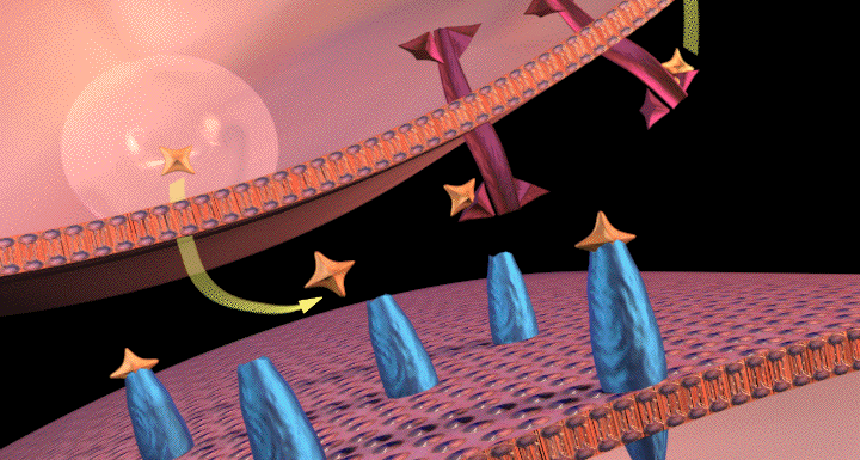Explainer: What is dopamine?
This chemical can help you move, but it can also affect mood, memory and more

This image shows the edges of two brain cells meeting. The orange stars are molecules of dopamine, leaving one cell and binding to the receptors (blue) on a neighboring cell.
National Institute on Drug Abuse
What do drug addiction and Parkinson’s disease have in common? Improper levels of dopamine (DOAP-uh-meen). This chemical acts as a messenger between brain cells. Dopamine is important for many of our daily behaviors. It plays a role in how we move, for instance, as well as what we eat, how we learn and even whether we become addicted to drugs.
Chemical messengers in the brain are called neurotransmitters. They shuttle across the spaces between cells. These messengers then bind to docking-station molecules called receptors. Those receptors relay the signal carried by the neurotransmitter from one cell to its neighbor.
Different neurotransmitters are made in different parts of the brain. Two main brain areas produce dopamine. One is called the substantia nigra (Sub-STAN-sha NY-grah). It’s a tiny strip of tissue on either side of the base of your brain. It sits in a region known as the midbrain. Close by is the ventral tegmental area. It, too, makes dopamine.
Story continues below video.
Neuroscientifically Challenged
These two brain areas are very thin and tiny. Together they are smaller than a postage stamp. But the dopamine they produce relays signals that travel throughout the brain. Dopamine from the substantia nigra helps us begin movements and speech. When the brain cells that make dopamine in this area start to die off, a person can have trouble initiating movement. It’s just one of the many symptoms ravaging people with Parkinson’s disease (a condition best known for uncontrollable tremors). To move normally, patients with Parkinson’s take a drug that lets them make more dopamine (or they get an implant that stimulates deep regions of the brain).
The dopamine from the ventral tegmental area doesn’t help people move — at least, not directly. Instead, this area usually sends dopamine into the brain when animals (including people) expect or receive a reward. That reward might be a delicious slice of pizza or a favorite song. This dopamine release tells the brain that whatever it just experienced is worth getting more of. And that helps animals (including people) change their behaviors in ways that will help them attain more of the rewarding item or experience.
Dopamine also helps with reinforcement — motivating an animal to do something again and again. Dopamine is what prompts a lab animal, for instance, to repeatedly press a lever to get tasty pellets of food. And it’s part of why humans seek out another slice of pizza. Reward and reinforcement help us learn where to find important things such as food or water, so that we can go back for more. Dopamine even affects moods. Things that are rewarding tend to make us feel pretty good. Lowering dopamine can make animals lose pleasure in activities like eating and drinking. This joyless state is called anhedonia (AN-heh-DOE-nee-uh).
Because of its roles in reward and reinforcement, dopamine also helps animals focus on things. Anything that’s rewarding, after all, is usually well worth our attention.
But dopamine has a more sinister side. Drugs such as cocaine, nicotine and heroin cause huge boosts in dopamine. The “high” people feel when they use drugs comes partly from that dopamine spike. And that prompts people to seek out those drugs again and again — even though they are harmful. Indeed, the brain “reward” associated with that high can lead to drug abuse and eventually to addiction.







